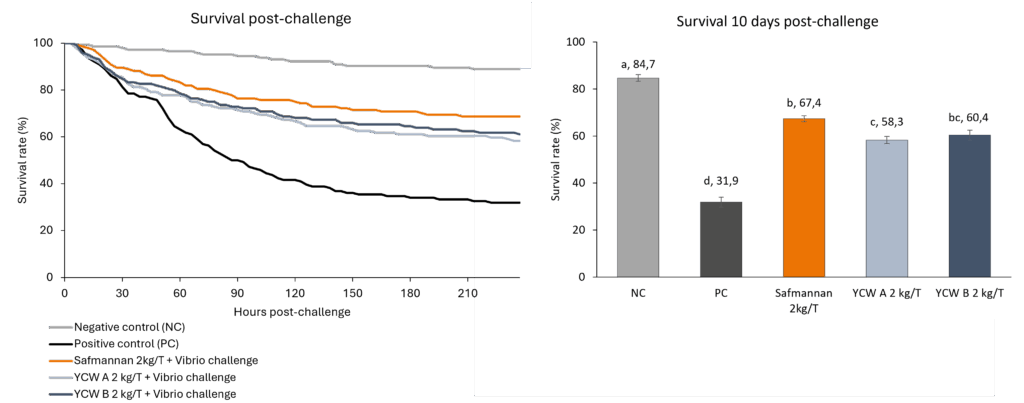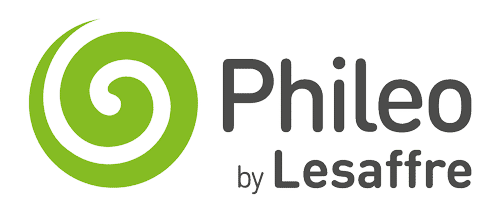14 Nov Performance beyond label
A grip on the immunostimulant market
By Jean-Benoît Darodes de Tailly, Alban Caratis and Nadège Richard
Shrimp health needs reliability, not just claims
Shrimp farming has become one of the fastest-growing sectors in global aquaculture—but also one of the most vulnerable. Across Asia and Latin America, the industry continues to grapple with persistent and recurring diseases caused by a wide range of pathogens and environmental stressors.
Historically, antibiotics and chemotherapeutics have been the go-to tools for disease control. Today, however, stricter regulations, evolving export market requirements, and growing awareness of antimicrobial resistance are prompting feed millers and farmers to seek more sustainable, residue-free solutions to safeguard shrimp health.
Among the many tools now in use, immunostimulants, especially those based on beta-glucans derived from yeast cell walls (YCWs)—are well established in the industry and widely applied during farming operations. Their role in supporting shrimp health is well recognised. However, this widespread adoption has also led to a flood of market entrants offering products with varying quality standards and, at times, uncertain origins and performance.
This has resulted in commoditisation, where fundamentally different products are treated as interchangeable, fueling a race to the bottom driven by cost competition. It also includes technical commoditisation, where the nuanced, science-based attributes that determine a product’s true effectiveness are often overlooked.
The race for β-glucans percentages – and why it misses the point
End users have traditionally been encouraged to choose β-glucan sources based on the percentage shown on specification sheets, assuming that ‘the higher, the better.’ However, this approach overlooks a range of critical factors, such as the yeast strain, production and extraction processes that define molecular structure,branching patterns, and the presence of additional functional components like mannan-oligosaccharides (MOS), which are essential for immune modulation and pathogen binding.
These overlooked aspects introduce significant variability in product effectiveness when used in shrimp aquaculture. To demonstrate these differences, we conducted a comprehensive disease-challenge trial comparing several yeast-based immunostimulants marketed for aquaculture and produced through distinct manufacturing processes.
The trial compared Safmannan®, a premium yeast postbiotic solution manufactured by Phileo by Lesaffre, using a carefully selected yeast strain and primary fermentation processes, with two other yeast cell wall (YCW) products. These were derived from spent yeast, typically by-products of the brewing or bioethanol industries. Table 1 provides a detailed overview of the tested products. All products were applied at their manufacturers’ recommended inclusion rate of 2kg per tonne – despite their contrasting origins, production processes, and compositions.
The trial was conducted at the ShrimpVet Research Institute in Ho Chi Minh City, Vietnam, utilising specific pathogen-free (SPF) whiteleg shrimp (Litopenaeus vannamei) from a Shrimp Improvement System (SIS) genetic line, which were challenged with a virulent strain of Vibrio parahaemolyticus (strain No. LA 37), the causative agent of early mortality syndrome (EMS).
The products were administered in feed throughout the full 25-day trial, which was divided into three distinct phases: a 14-day pre-challenge period, a 1-day exposure phase during which Vibrio bacteria were introduced into the water, and a 10-day post-challenge infection period. Shrimp survival was continuously monitored to evaluate the protective efficacy of each product against the infective agent. Each treatment group included six replicates and was compared against both unchallenged controls and challenged shrimp that did not receive immunostimulants.

Shrimp supplemented with Safmannan® showed a clear protective advantage against EMS-induced mortality. Survival rates were significantly higher compared to yeast cell wall product A and consistently superior—though not statistically different—compared to product B (Figure 1).
After 10 days of challenge, Safmannan® achieved a survival rate of 67.4%, more than double that of the positive control (31.9%) and markedly exceeding product A (58.3%). Product B achieved a survival rate of 60.4%, representing an improvement over the control, yet remaining numerically inferior to Safmannan®
Interestingly, Safmannan® also conferred a marked protective effect during the critical first 48 hours of the challenge, when mortality pressure from EMS is typically highest, and management responses by farmers are still possible. In contrast, the two other yeast products offered little to no improvement over the positive control during this phase of acute mortality.
In line with the higher survival observed in the Safmannan® group, shrimp fed with this solution maintained notably higher granulocyte counts (key immune cells driving defence against infection) both before and after EMS challenge (Figure 2). At 48 hours post-challenge, Safmannan® sustained granulocyte levels close to pre-challenge values (119 vs 127 ×10³ cells/mL), whereas counts in both YCW products dropped sharply.
This sustained immune cell availability suggests that Safmannan® helps shrimp preserve immune competence during the critical early phase of infection, when cellular depletion is normally expected. By maintaining functional immune cell populations, Safmannan® not only limits acute mortality but may also help reduce the risk of secondary infections, prolong immune functionality, and mitigate exhaustion under prolonged disease pressure.
These results highlight the clear advantages of yeast cell wall (YCW) products derived from selected strains and primary fermentation over products from brewing or bioethanol processes.
Safmannan® stands out for the structural complexity of its β-glucans. Highly branched molecules forming triple-helix conformations are known to enhance immune stimulation, and Phileo’s controlled extraction ensures consistency and preserves bioactivity. In contrast, spent yeast by-products often undergo harsher processing, degrading key structures and reducing efficacy.



Beyond β-glucans, Safmannan® provides a balanced matrix of mannans and chitin that further supports immune function and pathogen binding. Secondary fermentation YCWs typically show weaker molecular profiles, with less consistent activity.
In practice, these differences explain why products that appear similar on paper can deliver very different outcomes in the field, reinforcing the need for thorough scientific validation rather than reliance on β-glucan percentages alone.
Probiotics vs immunostimulants: Complementary, not interchangeable
Another challenge arises when other product categories, such as probiotics, are positioned as direct substitutes for immunostimulants. While probiotics offer welldocumented benefits, their broad and multifaceted mode of action differs from the targeted, rapid immune-priming effect that pure immunostimulants are specifically designed to deliver.
Commercial gut health probiotics used in aquaculture are derived from both bacterial and yeast origins. These products typically contain multiple species and strains, formulated to work synergistically through complementary mechanisms such as digestion support, competitive exclusion of pathogens, and anti-inflammatory effects. Gut health probiotics are valuable tools for maintaining intestinal health and enhancing performance under variable farming conditions.
However, their effectiveness tends to be limited when facing acute disease challenges, which often require more targeted and potent immune stimulation for shrimp to mount an adequate defence.
To assess these differences in practice, Phileo by Lesaffre carried out two EMS challenge trials at the ShrimpVet Research Institute in Vietnam (2023–2024), using whiteleg shrimp L. vannamei.
In both studies, Safmannan® was supplemented at 1 kg/ tonne for 15 days before challenge and benchmarked against two renowned Bacillus-based probiotic brands applied at their manufacturers’ recommended inclusion rates. After the 15-day supplementation period, shrimp were exposed to Vibrio parahaemolyticus (strain LA37).
Across both EMS challenge rounds, supplementation with Safmannan® consistently outperformed the two probiotic products (Figure 3). In round 1, Safmannan® achieved 65.4% survival compared with 46.5% and 44.7% for the probiotics, while the positive control dropped to just 22.3%. In round 2, survival with Safmannan® reached 76.7%, clearly higher than probiotic brand 1 (54.4%) and brand 2 (56.7%) and nearly doubling the survival rate of the positive control (41.1%).
Beyond biological performance, the economic interpretation is equally important. The cost-in-use of Safmannan® in these trials was more than ten times lower than that of the probiotics, yet it generated nearly double the survival benefit. This combination of higher efficacy and significantly lower cost underscores Safmannan®’s superior value proposition in practical farming conditions for this specific application.
Taken together, these results show that probiotics and immunostimulants serve distinct and complementary functions. Probiotics support long-term gut health and performance, but in acute disease challenges, they offer little protection. Safmannan®, contrastingly, provided rapid immune support, consistent survival benefits, and a markedly more cost-effective solution—highlighting its role as a cornerstone in strengthening shrimp resilience.
Choosing wisely in a crowded market
In categories often viewed as commoditised, where products appear similar on paper, our results clearly show that meaningful differences exist in both performance and cost-in-use. Production origin, molecular structure, and processing methods can translate into distinct outcomes in terms of shrimp survival and resilience.
This highlights the need for a deeper understanding of product attributes and their application. In shrimp farming, especially where multiple additives are often combined, achieving the right balance between efficacy and economics depends on choosing solutions based on evidence rather than surface similarities. Moving beyond labels and percentages toward validated performance is essential for building a more resilient and sustainable future for shrimp aquaculture.
References are available on request







Sorry, the comment form is closed at this time.